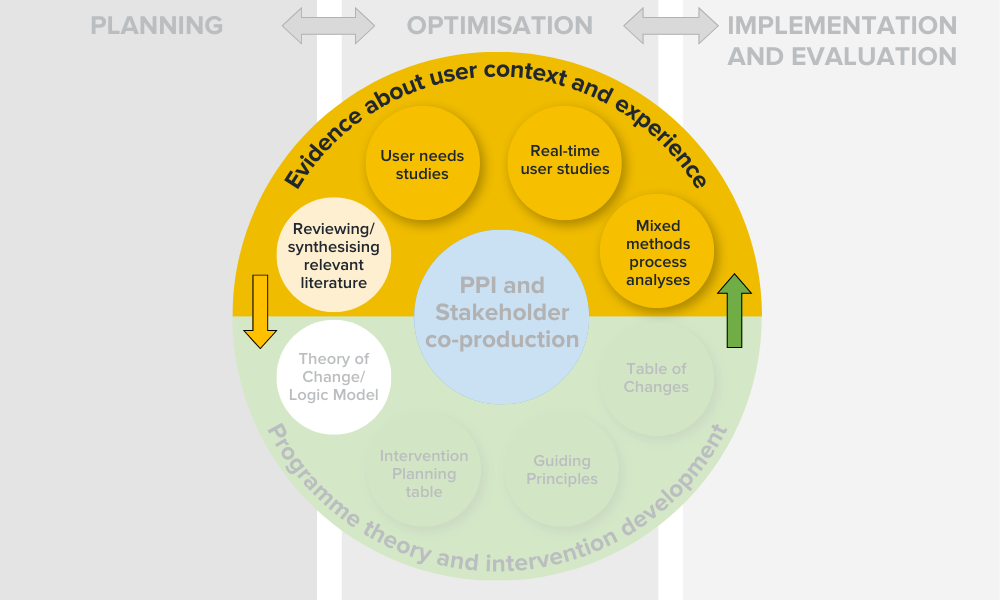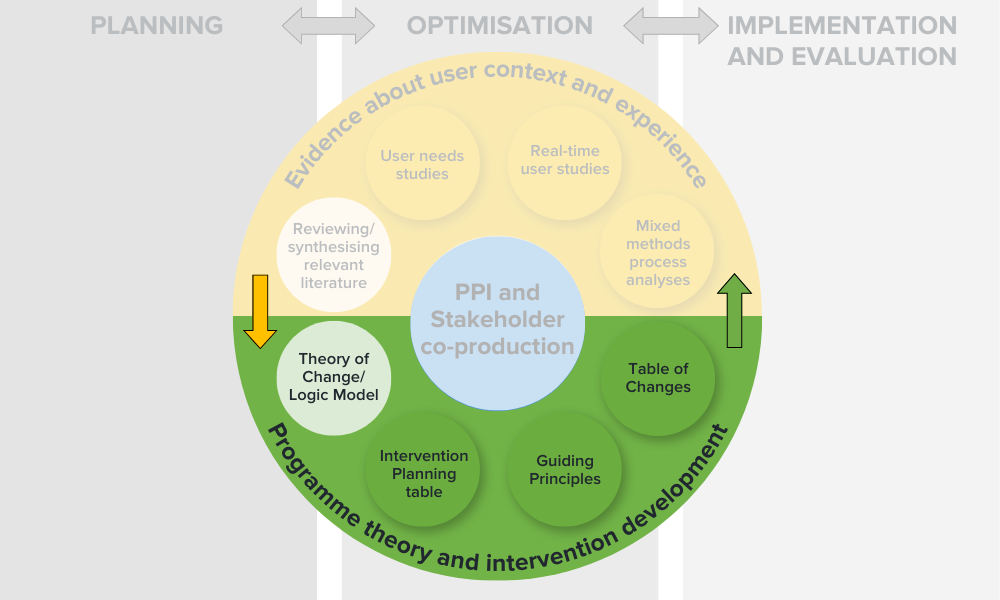Introduction to a person-based approach

Share this step
This activity was developed by Dr. Rosie Essery, a Health Psychologist and Senior Research Fellow at the University of Southampton. The internationally recognised Person-Based Approach (PBA) describes iterative methods for planning, optimising, evaluating and implementing behavioural health interventions that can successfully engage diverse users and support better health-related outcomes.
The PBA offers practical methods of carrying out many of the key intervention development activities recommended by the new Medical Research Council (MRC) and Identifying and Critiquing Different Approaches to Developing Complex Interventions (INDEX) study guidance such as involving stakeholders, understanding context, and developing a programme theory.
The PBA has previously been used to develop interventions to help healthcare professionals to safely review and reduce antibiotic prescribing.
What is the PBA?
The PBA combines stakeholder and Public and Patient Involvement (PPI) co-production with in-depth qualitative and mixed methods research with a diverse range of people. Using the PBA will enable you to:
- Understand and meaningfully address the views, needs and experiences of intervention users
- Understand the context within which users are engaging with the intervention or behaviour change
- Consider how theory- and evidence-based content can be delivered and communicated in the most engaging and persuasive way
- Discover the need for new intervention features that are not yet evidence-based or indicated by existing theory
- Systematically document, agree and prioritise required intervention elements and changes
- Identify and resolve problems with user engagement early so that fewer resources are wasted evaluating or implementing ineffective interventions
Using the PBA
The PBA is an iterative method designed to be used at any or all stages of the cycle of planning, developing, optimising and evaluating interventions. It can be combined with other approaches to intervention development and evaluation, user centred design methods and PPI.
The PBA can be used flexibly, depending on the needs and resources of your development team. It has been used for:
- Very rapid development (e.g. of interventions to combat the Covid-19 pandemic)
- Development by a very small team with limited resources (e.g. a student project)
- In-depth development of very large interventions by multinational teams
The PBA process
The infographic below details some of the key components of the PBA process.
PPI and stakeholder co-production

Click here to take a closer look
Public and Patient Involvement (PPI) and input from other stakeholders is crucial to ensure that interventions are accessible, engaging, and meet users’ goals.
We have developed easy to use tools, such as our Intervention Planning Table and Table of Changes, that support PPI and stakeholder involvement in co-producing and optimising interventions.
A ‘stakeholder’ is anyone who could have a ‘stake’ in the intervention, including potential users and potential providers (such as healthcare professionals or other practitioners, policy makers, businesses or community organisations). PPI in research is a particular type of stakeholder involvement.
PPI and stakeholder involvement is at the centre of the person-based approach (PBA), and is vital to ensure that interventions are engaging and useful for the people who use them.
How PPI and stakeholders are involved in the PBA is extremely flexible, and can include:
- Contributing as an essential part of the core research team to all key decisions about intervention planning, optimisation and/or implementation
- Contributing to one or more additional consultations – for example, through workshops, focus group discussions or providing online commentary. This kind of PPI activity can be supplemented by qualitative research
Embedding diversity in PPI and stakeholder engagement
It is vital to make sure your PPI and stakeholder activities allow and encourage a wide range of people to take part. Some people may feel more confident to input if they are in a group of people they know or who are like them. People with less confidence, time or motivation may prefer to input if they do not have to travel, make a long-term commitment or take part in large discussion groups.
How PPI and stakeholders are involved in the PBA will often depend on the aims of your project and the time you have.
If you want to read more about how PPI and stakeholder involvement has been incorporated in the PBA across three different projects, follow this link.
Evidence about user context and experience

Click here to take a closer look
It is vital to collect evidence about the views, context, and experiences of users in order to understand how to make interventions engaging and useful.
A wide range of methods can be used, including:
- studies of user needs
- real-time studies of users’ immediate reactions to each element of the intervention
- qualitative process analyses of user experiences of engaging with interventions, quantitative process analyses of how intervention usage relates to outcomes and user characteristics
- reviews and syntheses of existing theory and research
Programme theory development and refinement

Click here to take a closer look
The programme theory explains how the intervention is meant to achieve its goals.
The standard logic model describes how the key elements of the intervention should lead to intended outcomes. The PBA also develops Guiding Principles to describe how the intervention design should support engagement and uses the Intervention Planning Table and Table of Changes to record in detail why intervention elements were selected or changed.
Planning, optimisation, implementation, and evaluation

Click here to take a closer look
At the planning stage of intervention development we co-produce a logic model, Guiding Principles, and an Intervention Planning Table that set out how the intervention should meet user goals. We draw on existing theory and research, and if this does not provide enough evidence we carry out qualitative and/or quantitative User Needs Studies.
Optimisation is a cyclical process of asking users to try the intervention and gathering qualitative and quantitative evidence about their experiences from real-time studies of users’ initial reactions to the intervention and qualitative and quantitative process analyses of users’ experiences of engaging with the intervention in a real world context over time. We then collate this evidence in the Table of Changes to inform decisions on how the intervention needs to be adapted and improved.
The cycle of implementation and evaluation feeding into optimisation can occur at any stage of intervention development, from small feasibility studies to process analyses of large trials, or real-world intervention deployment and adaptation.
Follow this link more information and resources about the PBA.
A full list of PBA publications can also be found on the website here, but some key papers are linked below.
In the comments below, please let us know:
- How do you think the PBA might help with developing interventions in your field of work?
- Which elements of the PBA could you potentially incorporate into your own work?
When ready please click ‘next’ to learn more about the person-based approach.
Share this
Tackling Antimicrobial Resistance: A Social Science Approach

Tackling Antimicrobial Resistance: A Social Science Approach


Reach your personal and professional goals
Unlock access to hundreds of expert online courses and degrees from top universities and educators to gain accredited qualifications and professional CV-building certificates.
Join over 18 million learners to launch, switch or build upon your career, all at your own pace, across a wide range of topic areas.
Register to receive updates
-
Create an account to receive our newsletter, course recommendations and promotions.
Register for free







